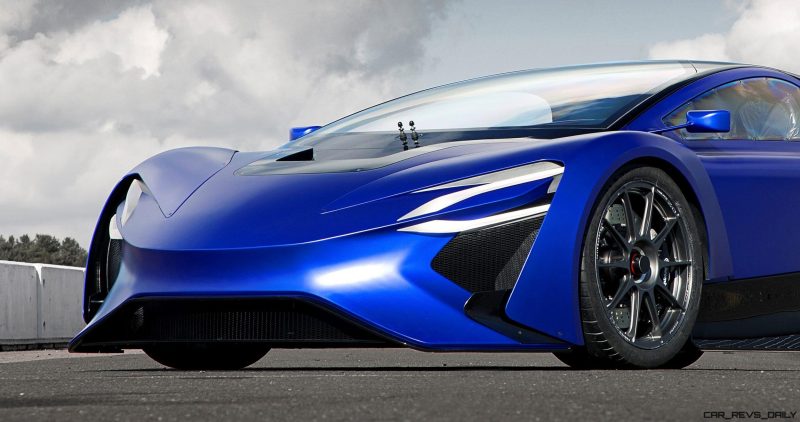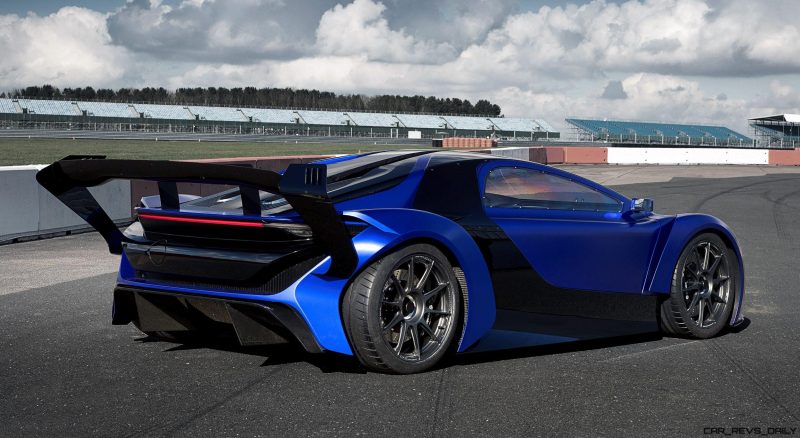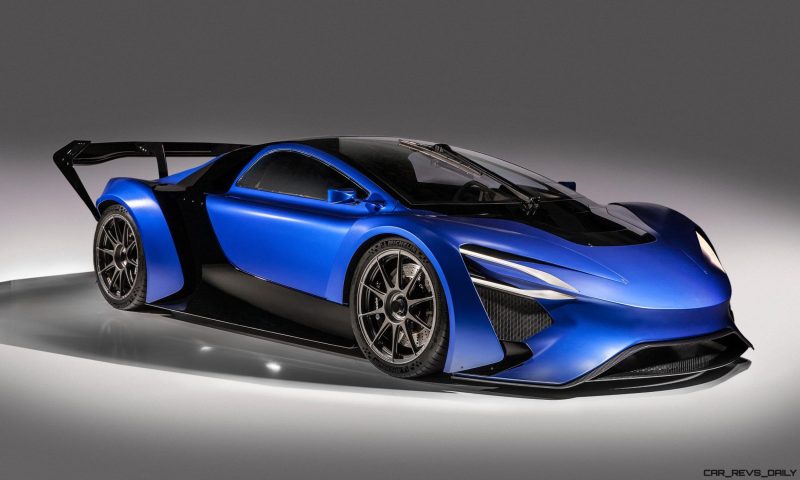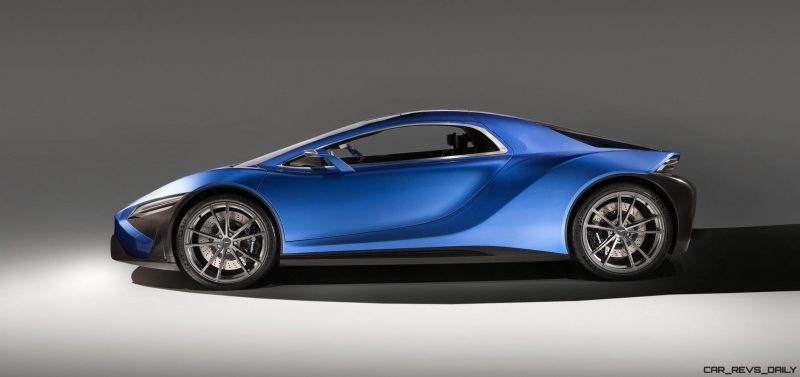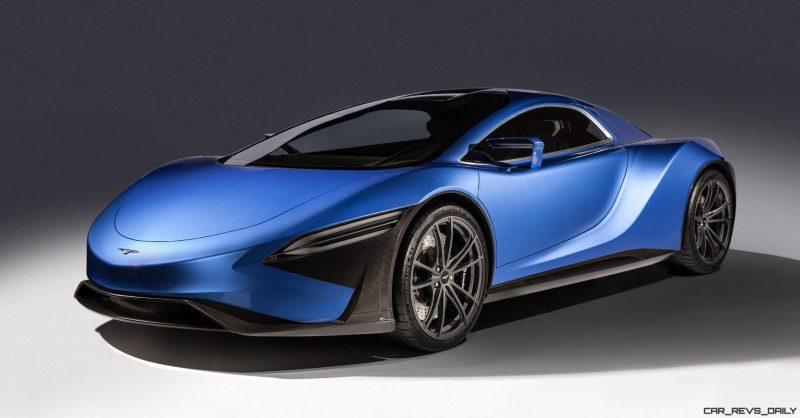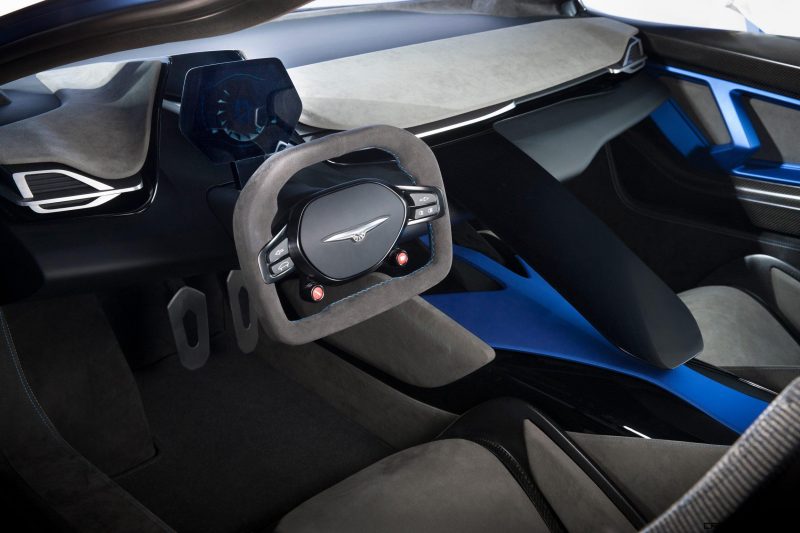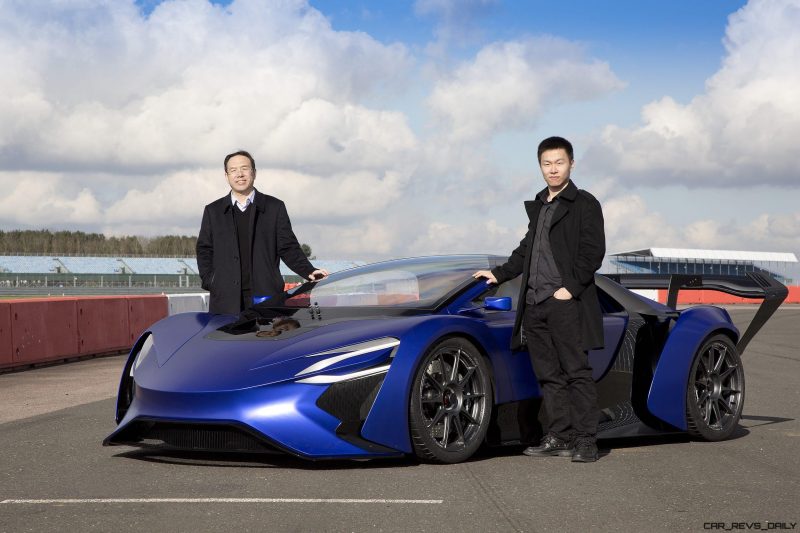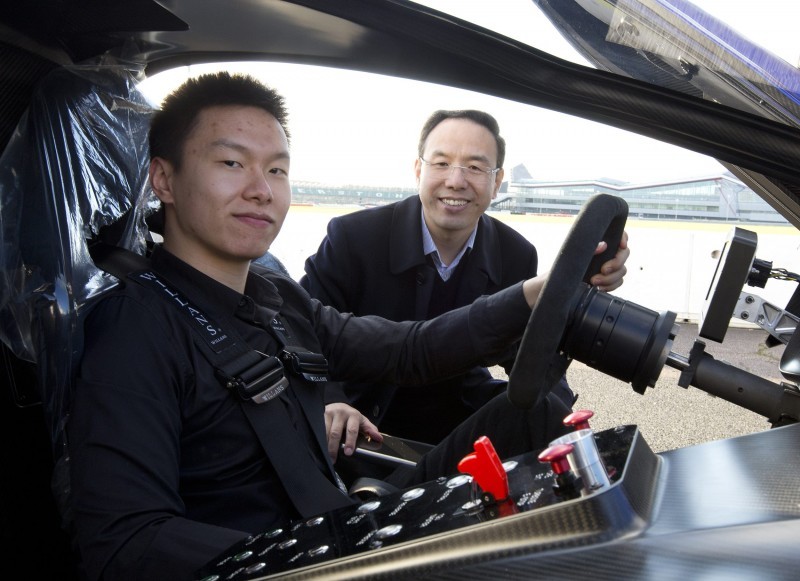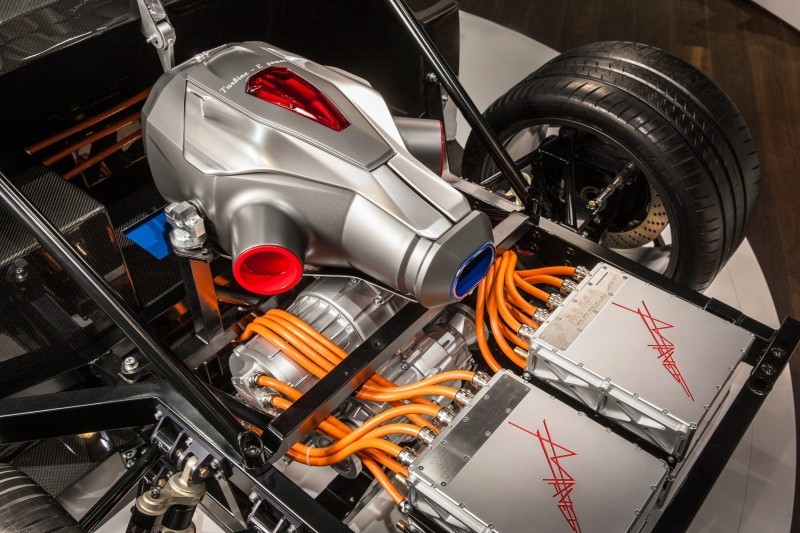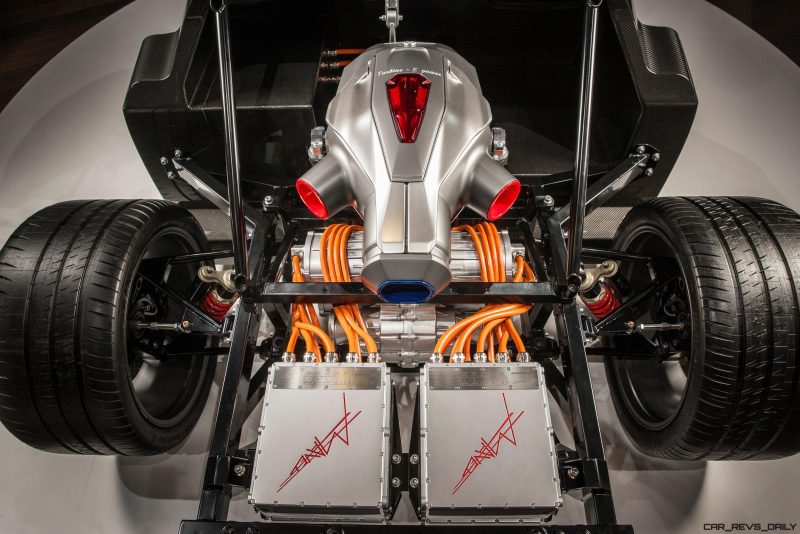Very promising debut from TechRules today! The AT96 is the supercar startup’s launch prototype, making its big-league entrance in Geneva after a round of testing at Silverstone and years of development in China.
The core premise is to introduce a revolutionary new turbine-recharged EV powertrain — and make it viable as a hypercar!
Of course, keen readers will recall the many turbine misadventures in automobiledom, from the Chrysler Turbine cars to the original powertrain of the canceled Jaguar C-X17 prototype.
The idea of turbines to deliver an EV charge makes perfect sense. Military vehicles have employed this tech for decades.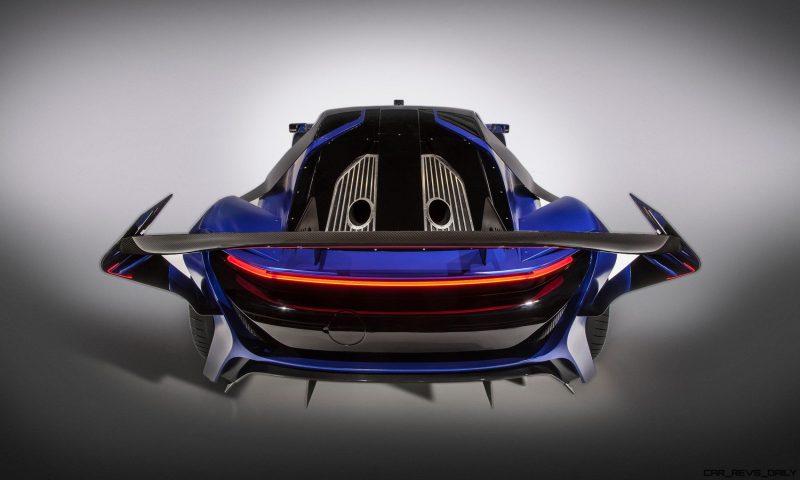
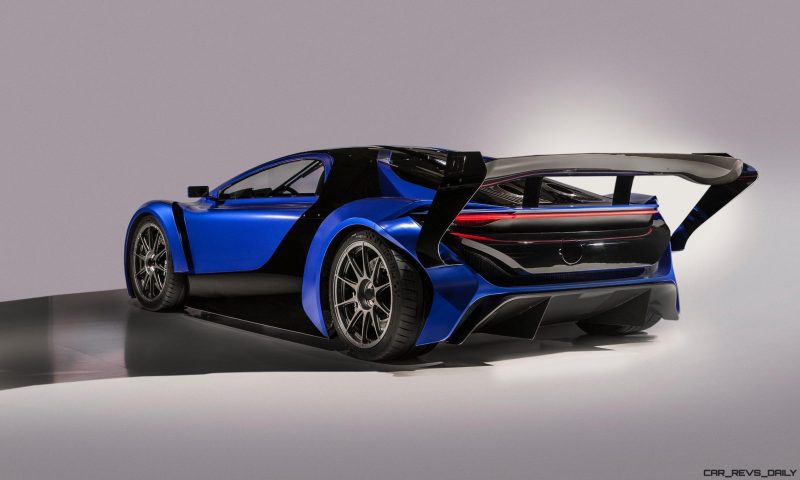
Functionally, the TechRules AT96 is a full EV. But the idea is that is will never, or very rarely, need to be plugged in. The turbine can kick on and hummm its way to full battery power fairly quickly. Just 15-minutes, in fact, of turbine will charge the batteries in full.
The problem with turbines has always been their sheer complexity to manufacture at scale. And, of course, their very laggy direct power delivery. This slower-than-pistons ramp-up of power production makes them unsuited for directly propelling the vehicle rapidly.
But as an on-board super-charger (so to speak), a turbine system can keep batteries fully charged at all times. This should, in theory, allow supercar-level pwerformance from the EV motors.
720-volts is the output of the AT96 — right up there with the upcoming 800V Koenigsegg Regera.
Performance of the AT96 looks scary-fast — as does its incredible track aero kit.
Welcome to the main stage, TechRules.
May you solve the turbine riddle once and for all!
2016 TechRules AT96 TREV Supercar Concept
TECHRULES DEBUTS REVOLUTIONARY ELECTRIC VEHICLE TECHNOLOGY IN CHINA’S FIRST SUPERCAR CONCEPT
- Geneva world premiere for new Chinese R&D business, Techrules, and its proprietary Turbine-Recharging Electric Vehicle (TREV) technology
- The solution for next generation EVs, TREV promises to deliver unprecedented range and efficiency
- Techrules will introduce China’s first supercar – featuring TREV technology – within a few years, with city cars to follow in the following years
- Running prototype concept supercar boasts projected peak power of 1,030 bhp, range of over 2,000km, and fuel economy of 0.18 l/100km
Geneva, 1 March 2016 – Techrules, a new China-based automotive research and development company, is making its global debut at the 2016 Geneva International Motor Show. It is dedicated to the innovation of new energy technologies to advance the environmental and dynamic performance of EVs as well as the convenience to the user.
It has developed a Turbine-Recharging Electric Vehicle (TREV) system, an all-new patent-protected series hybrid powertrain technology comprising a turbine-generator. TREV combines extensive experience of aviation and electric vehicle technologies with several proprietary technical innovations to deliver unprecedented levels of efficiency and performance, and ultra-low environmental impact.
TREV is a range extender system that uses a micro-turbine to generate electricity that charges a battery pack. The battery powers the motors that drive the wheels. Newly developed battery management technologies enable superior charging efficiency. The high efficiency of the TREV range extender results in a requirement for fewer batteries, saving weight and space.
Techrules is showcasing its ground breaking technology at the 2016 Geneva International Motor Show in a plug-in hybrid range extender TREV concept that represents the first step towards production of China’s first supercar. A development prototype started testing last month (February 2016) at the world-famous Silverstone race circuit in the UK.
Producing peak power of 768 kW (1,030 bhp / 1,044 PS), initial projections indicate blistering performance (0 – 100 km/h in 2.5 seconds; 350 km/h restricted top speed) and a huge range (over 2,000 km). Under plug-in operation, it achieves fuel consumption of just 0.18 l/100 km (1,569 mpg).
Techrules plans to begin series production of TREV technology in a low volume supercar of its own design within a couple of years. It then plans to begin production of higher volume city cars a few years later.
William Jin, the founder and CEO of Techrules, said: “The TREV system is a perfect combination of micro turbine and electric vehicle technologies. It is highly efficient, produces very low emissions and provides an optimal charging solution for electric vehicles.
“We believe it may redefine how the next generation of electric vehicles is powered.”
———
FURTHER DETAILS
Turbine-recharging electric vehicle (TREV): a revolutionary range extender technology for next generation EVs
TREV is an all-new proprietary, patent protected series hybrid powertrain system. It comprises a micro turbine generator that is inspired by technology commonly used in the global aviation industry and large-scale power generation industries. The turbine drives a generator which charges a battery. This in turn, provides electricity to drive the traction motors. Unlike many previously developed turbine powertrain systems, there is no direct electrical feed from the generator to the electric motors: the TREV system is purely a series hybrid range extender system.
Air drawn into the micro turbine is passed through a heat exchanger where heat from the exhaust air is transferred to the cold intake air after it has been compressed. Ignition of the compressed and heated fuel-air mixture generates enormous energy which is channelled to at very high speeds to turn the turbine vanes. As this hot exhaust gas is expelled, it passes through the heat exchanger to ensure the heat energy is recuperated and transferred to cold intake air.
Techrules Chief Technology Officer, Matthew Jin, explains: “In the conventional cars that dominated the 20th century, the combustion engine that converts a fuel’s chemical energy into a useful mechanical energy is also the driving engine that turns the wheels.
“Because turbines have always been a very inefficient way to convert chemical energy into useful wheel turning mechanical energy, only a few have tried to use a turbine in the powertrain system, and none have ever succeeded commercially.
“But, with electric vehicles, an electric motor is used to drive the wheels, which effectively frees the combustion engine to exclusively convert chemical energy into mechanical energy and finally into electric energy. This is a major breakthrough, making it possible for us to use the highly efficient turbine engine as a superb range extender on our vehicles.”
Micro turbines are significantly more efficient than piston engines in range extender applications, because significantly less energy is sacrificed in frictional losses, meaning more of the fuel’s chemical energy is harnessed.
The turbine shaft powers a generator that produces electricity to charge the battery cells. In Techrules’ TREV configuration, the turbine and the generator share the same shaft and rotate at the same speed: over 96,000 revolutions per minute.
The total weight of the TREV range extender system (micro-turbine, inverters, fuel pumps, air pumps, and generator, but excluding batteries and motors) is approximately 100 kg.
TREV system features proprietary innovative technologies for unprecedented levels of efficiency
The TREV system incorporates several new technologies that make it approximately 50 per cent more efficient than range extender systems using petrol engines, which dramatically increases the viability of its commercial series production.
The high rotational speeds that the shaft requires in order to draw in the required volume of air means that achieving low friction is paramount to the efficiency of the TREV system.
Techrules employs air bearing technology – a high pressure feed of compressed air – instead of a traditional oil lubricant film to separate the shaft from the bearing. This results in fewer frictional energy losses, since it eliminates parasitic losses of a mechanical bearing. The use of an air bearing system is not unique, but how Techrules uses the air bearing involves genuine world-first innovations.
Of particular note is that the air bearing is also supported by a magnetic field that allows for precise adjustment of the high speed shaft. Both bearing solutions work together to maintain exceptional stability. The magnetic bearing allows a far greater clearance between the shaft and its wall lining, which delivers significant advantages for the long-term durability of the system.
This is an especially important consideration in automotive applications of turbine systems because – unlike in stable power generation conditions – the entire assembly must be able to be capable of withstanding volatile operating conditions that result from, for example, vertical shocks from uneven road surfaces and lateral forces in cornering. Techrules’ hybrid bearing system is also more economic to produce, because the built-in extra clearance space reduces the extreme tolerances usually required.
In addition, a new design of internal foil – an intrinsic component within an air bearing – is used for the bearing liner that supports the air pressure and flow. It is made of a new compound material that gives it superior durability. Of equal importance is that the new foil enables the mass production of the bearing liner at the required production tolerances to be achieved at a high volume scale at low cost.
Techrules has also introduced a new and innovative heat exchanger design that is more thermally efficient than conventional designs. A new material has been introduced in the hybrid heat exchanger which greatly increases the efficiency of heat recuperation from the exhaust gases.
The turbine – rotating at 96,000 revolutions per minute – produces 36 kW. Of this output, 30 kW powers the generator, with 6 kW directly powering auxiliary equipment such as the inverters. The 30 kW electrical output from the generator is used to charge the battery pack.
Smart battery management with new charge balancing strategy
The TREV system employs an innovative smart battery management system that optimises the efficiency of battery charging and power balancing between battery cells.
In a conventional lithium-ion battery management system, to avoid cells being damaged by overcharging, the cells – which each charge at a slightly different rate –
must be balanced as they charge. This balancing is conventionally achieved by actively discharging the cells that are charging more quickly in order to enable the other cells to ‘catch up’. This process sees a proportion of energy wasted during the charging process and increases the time required to charge all cells fully.
To address the shortcomings with this standard industry practice, Techrules has introduced an innovative new charge balancing strategy. The smart battery balancing system harnesses the ‘excess’ voltage in cells that are charging more quickly, sharing their charge with slower-charging neighbouring cells to achieve the required balance. As a result, the entire pack charges more quickly, and there is no energy wasted in actively discharging the best-performing cells.
The TREV system uses readily available cylindrical 18650 Lithium-Manganese-Oxide battery cells. Techrules is focusing its capabilities on the efficiency of the battery management rather than the battery chemistry itself. Its insight and smart battery management system will be applicable to any future, higher capacity battery technology.
Unlike most EV development programmes, because the TREV system incorporates a series hybrid range extender, Techrules is prioritising power density – the capability of the batteries to deliver peak power – ahead of energy density – the capability of the batteries to hold maximum energy
TREV’s advanced smart battery management system optimises the efficiency of battery charging, reducing the time to charge batteries and reducing wasted energy.
Reduced whole-life environmental impact
TREV technology lowers the whole-life environmental impact of EVs by addressing or avoiding several major shortcomings of current technology.
TREV is capable of delivering an unprecedented range for a series hybrid supercar.
Projections, based on initial testing, indicate that the range of a future production supercar under battery power alone will be up to 150 km. Where charging points are unavailable TREV technology can recharge batteries anywhere, either while underway or when parked – eliminating range anxiety. It is envisioned that this parked recharging process could be completed unsupervised, overnight for example.
Maximum range – based on the battery configuration in the concept supercar presented at Geneva – is projected to be over 2,000 km from 80 litres of aviation kerosene (in urban driving conditions), or a fuel with equivalent calorific value.
Another fundamental challenge to the feasibility of mass adoption of EVs in several markets is the massive draw on the electricity grid that would be impossible to meet within the current grid capacity. If the Chinese market, for example, adopted plug-in EVs, the result would be a massive increase in pollution from coal-fired power stations. And many markets in the western world, too, are precariously close to the limit of the electricity generation capacities of their power generation infrastructures. These markets would not be able to sustain a widespread adoption of plug-in EVs.
With a common core architecture, the TREV system can be tailored to run on one of a variety of fuels. This means that the configuration of the TREV system can be matched to the fuel which is already prevalent in a specific market with a comprehensive supply and distribution infrastructure. As a result, adoption of the TREV system by the fuel supply industry, vehicle manufacturers and consumers requires no major investment in new networks – as with plug-in EVs or hydrogen fuel cells. The TREV system’s turbine has been tested in various guises, with alternative versions running natural gas, biogas, diesel, gasoline and aviation kerosene.
Since the significant uptake of EVs is dependent on the availability of charging point networks, which require major investments in new infrastructure, harnessing the existing fuel distribution infrastructures reduces the absolute reliance on these networks.
The TREV system delivers very high efficiency and very low emissions, and is a sealed-for-life powertrain solution which requires almost zero maintenance throughout the ownership cycle. The only service item is the air intake filter.
Concept is a vision of future production TREV supercar
Techrules is showcasing its TREV technology at the 2016 Geneva International Motor Show in a two-seater all-wheel drive concept supercar. The turbine generator is carried behind the passenger cabin and in front of the rear wheels, making the concept a ‘mid-engined’ electric vehicle.
It is presented in two designs, the AT96 and GT96. These designs – each offering an alternative configuration of the TREV system – are two variations of a vision of how turbine-recharging supercars might look when the technology enters production in China’s first supercar.
‘AT’ refers to ‘Aviation Turbine’, indicative that the turbine is configured to run on a liquid fuel such as aviation kerosene, diesel and gasoline. The AT96 is a vision of a track-focused version of the supercar and features management large rear wing, which provides both straight-line stability as well as downforce to aid high speed cornering.
The GT96 – for gas turbine – is designed to run on a gaseous fuel such as biogas and natural gas and is styled as a road-going hypercar.
The supercar also incorporates plug-in charging capability for markets where public or residential off-street parking charging networks – ideally powered by renewable energy sources – are in place.
A first supercar development prototype – based on the AT96 aviation turbine configuration – has been produced by Techrules’ specialist vehicle engineering partners in Italy and the UK. Initial testing began in February 2016 at the iconic Silverstone race circuit in the UK.
The range of the supercar concept on plug-in battery power alone is projected to be up to150 km, with a total range of over 2,000 km from 80 litres of aviation kerosene – or a fuel with the equivalent calorific value – with the TREV range extender deployed.
The combined peak output of the motors is 768 kW (1,030 bhp / 1,044 PS) and maximum torque at the wheels is projected to exceed 8,600 Nm (6,300 lb ft). With such power available with such brutal immediacy, the Techrules supercar concept boasts performance to rival today’s hypercars: 0 – 100 km/h in 2.5 seconds; top speed electronically restricted to 350 km/h.
Fuel consumption is projected to be just 0.18 l/100km. With a full charge provided solely by the TREV system, fuel consumption is expected to be approximately 4.8 l/100 km.
The kerb weight of the development vehicle is currently 1,380 kg. The target for the future production supercar is a sub-1,000 kg dry weight.
At the heart of the concept is a carbon-fibre monocoque to provide exceptional torsional rigidity and passenger safety. The body structure is also lightweight carbon fibre, including the dihedral doors.
The rear subframe carries the primary range extender components, including the micro turbine generator and direct ancillary systems, as well as the cooling systems for the electric traction motors and battery pack, and the rear motors and inverters.
Under the carbon-fibre body, a longitudinal T-shaped battery back runs down a central spine of the car – providing the same appearance in the passenger cabin as a transmission tunnel would in a front-engine, rear wheel drive car. The battery pack is liquid cooled to maintain an optimal operating temperature for the cells.
The battery pack comprises 2,376 individual 18650 cylindrical cells that use the ultra-safe Lithium-Manganese-Oxide chemistry (LiMn) chemistry with a capacity of 20 kWh usable and with a voltage of 720 V. Thanks to its smart battery management system, the battery pack can be charged by the turbine generator in approximately 40 minutes.
The supercar concept is driven by six electric traction motors, each weighing 13 kg and each one of which is coupled to its own dedicated inverter. Each front wheel is driven by a single motor, while each rear wheel is driven by a pair of motors.
The primary advantage of using two smaller motors instead of a single larger motor for each rear wheel is packaging efficiency and simpler mounting to the monocoque.
This six-motor layout with independent power feeding each wheel provides an ideal configuration for torque vectoring which is managed by an electronic control unit. Four-way torque vectoring guarantees maximum cornering stability at high speed and eliminates the requirement for complex and heavy mechanical differentials.
With such power and speed available from the accelerator pedal, so is there due consideration for high performance stopping power. Rapid retardation is achieved with 405 mm ventilated discs with six-piston calipers at the front, and 380 mm ventilated discs with four-piston calipers at the rear.
The current plan is for a TREV-powered supercar to be produced and sold in low volumes within the next few years. The low volumes will help Techrules perfect the production process of the TREV system and learn from its performance in real world conditions as it further develops the system for higher volume production.
Introducing TREV technology in its own supercar will also allow Techrules to demonstrate its credentials as an environmentally-friendly technology that can deliver exceptional dynamic performance. As it evolves quickly from an automotive research and development business into a car manufacturer, Techrules aims to lead a symbolic shift by the Chinese car industry towards world-class automotive quality and performance standards.
Following its launch with low volume supercars, Techrules’ will then develop its capabilities to realise its next ambition: the development of the technology for high volume applications including sub-compact and compact (B- and C-segment) cars, to be introduced to the market a few years later.
Techrules – a new company heralding a new dawn for the automobile
Techrules is a Beijing-based automotive research company focused on developing groundbreaking powertrain technology and fuel-efficient and environmentally friendly vehicles.
Its founders believe that future cars should be more efficient, more environmentally-friendly, and with better user experience than what is available on the market today. To achieve this, vehicles need to minimize whole-life well-to-wheel emissions that piston engine and plug-in EVs are failing to make significant progress with.
Techrules is a subsidiary of Txr-S, a research and development company which has other subsidiaries operating in the fields of new materials development, biogas production and aerospace.
Performance (all projections based on initial testing of concept supercar development vehicle)
| Power output | 768 kW (1,030 bhp / 1,044 PS) |
| Torque at the wheels: | |
| Front | 2,880 Nm (2124 lb ft) |
| Rear | 5,760 Nm (4248 lb ft) |
| Total | 8,640 Nm (6372 lb ft) |
| Acceleration (0-100 km/h) | 2.5 seconds |
| Max speed | 350 km/h |
| Fuel consumption | 0.18 l/100km |
Transmission
| Number of gears | 1 |
Battery pack
| Voltage | 760 V |
| Battery type | Lithium-Manganese-Oxide |
| Capacity | 20 kWh usable |
| Thermal management | Liquid cooling |
| Battery and thermal management systems with several layers of redundant safety and protection systems. |
Chassis
| Construction | Carbon-fibre monocoque |
| Front suspension | Double wishbone |
| Rear suspension | Double wishbones |
| Wheel / tyre size front | 9.5Jx20 / 265/35 R20 |
| Wheel / tyre size rear | 11Jx20 / 325/30/R20 |
Dimensions
| Length | 4648 mm |
| Width | 2034 mm |
| Height | 1140 mm |
| Wheelbase | 2655 mm |
| Track front / rear | 1740 mm / 1653 mm |
| Dry weight | 1380 kg |
Brakes
| Front | Ventilated discs Ø 405 mm, 34 mm wide, with six-piston calipers |
| Rear | Ventilated discs Ø 380 mm, 28 mm wide, with four-piston calipers |
Steering
| Rack and pinion electrically power assisted steering. |
Safety systems
| ABS |
| Torque vectoring with stability function |
| Safety disconnect systems |
| Multiple ECU architecture for monitoring of safety-relevant electronic systems |
– Ends –
Notes to editors
Techrules press conference at the 86th Geneva International Motor Show
12.15pm, Tuesday 1 March 2016
Stand 2051 in Hall 2
About Techrules
Techrules is a new automotive research and development company based in Beijing, China. Its mission is to develop automotive powertrain technologies to help next generation vehicles be more efficient, more environmentally-friendly, easier to use and deliver a better user experience.
Techrules is a subsidiary of Txr-S, a research and development company which has other subsidiaries operating in the fields of new materials development, biogas production and aerospace.

Tom Burkart is the founder and managing editor of Car-Revs-Daily.com, an innovative and rapidly-expanding automotive news magazine.
He holds a Journalism JBA degree from the University of Wisconsin – Madison. Tom currently resides in Charleston, South Carolina with his two amazing dogs, Drake and Tank.
Mr. Burkart is available for all questions and concerns by email Tom(at)car-revs-daily.com.







